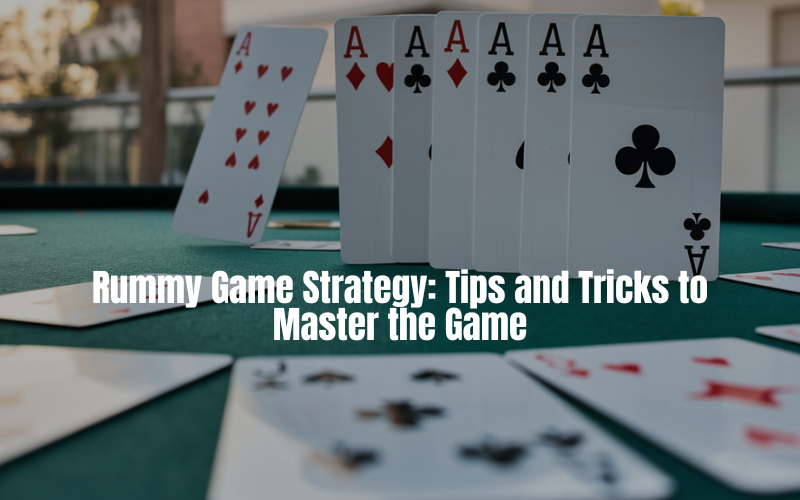Rummy is a skill-based card game that requires a combination of strategy, calculation, and a bit of luck to win. While the basic rules are straightforward, becoming proficient involves a deep understanding of strategies to outsmart your opponents. Whether playing casually with friends or in high-stakes online competitions, employing the right tactics can significantly increase your chances of winning. This article will discuss essential Rummy game strategy that can help you improve your game.
Understanding the Basics of Rummy
Before delving into strategies, it’s essential to understand the primary goal of Rummy. The objective is to form valid sequences and sets using the 13 cards dealt to you. A sequence is a consecutive arrangement of cards in the same suit, while a set is a collection of cards with the same rank but different suits.
Key Definitions:
- Pure Sequence: A sequence formed without using a Joker. Having at least one pure sequence to declare a valid hand is crucial.
- Impure Sequence: A sequence formed using one or more Joker cards.
- Set: A group of three or four cards of the same rank from different suits.
The Importance of a Rummy Game Strategy
A pure sequence is the backbone of any winning in Rummy game strategy. You cannot declare your hand without a pure sequence, even if all other cards are arranged. Therefore, your first goal should always be to form a pure sequence as quickly as possible. This reduces the risk of significant penalties in the event of an opponent’s early declaration.
Strategy 1: Prioritize the Pure Sequence
Forming a pure sequence early should be your top priority. Since you cannot declare without one, arrange your cards into a pure sequence right from the start. If your opponent declares early, holding on to high-value cards without creating a sequence can result in a higher score (which is not ideal in Rummy).
How to Do It:
- Look for consecutive cards in the same suit as soon as the game begins.
- Keep track of the discarded cards that can help you form a pure sequence.
- Avoid using a Joker to form your first sequence—reserve it for impure sequences or sets.

Strategy 2: Discard High-Value Cards Early
High-value cards (J, Q, K, A) carry 10 points each and can be a liability if you hold on to them for too long without forming a sequence or set. Discarding these cards early in the game is smart unless they fit into your sequence. This minimizes your points if your opponent declares before you’re ready.
How to Do It:
- If you still need to form a sequence with high-value cards by the first few turns, discard them.
- Replace high-value cards with middle-range cards (5, 6, 7, 8) that are more versatile for forming sequences and sets.
- Monitor the game to see if others are discarding high-value cards, which may indicate they are also focusing on reducing their points.
Strategy 3: Use Jokers Wisely
The Joker is one of the most powerful cards in Rummy because it can be used to substitute any card in an impure sequence or set. However, using the Joker smartly is essential, especially in high-stakes games. Ideally, save Jokers for forming an impure sequence or completing a set rather than wasting them on low-value combinations.
How to Do It:
- Do not use the Joker to complete a pure sequence—it’s better for forming impure sequences or sets.
- If you’re holding onto two high-value cards and need one more to complete a set, use the Joker instead of waiting for the perfect card.
- Remember that using a Joker to complete a set or sequence is beneficial only if you’re running out of moves; otherwise, prioritize completing combinations without it.
Strategy 4: Observe Your Opponents
Observing your opponents’ behavior, such as poker, can give you clues about their strategy. Are they picking up a lot of cards from the open deck? Are they discarding high-value cards early? These actions can help you anticipate their moves and adjust your strategy accordingly.
How to Do It:
- Pay attention to the cards your opponents pick from the open pile. If they take a card you discarded, avoid giving them more cards that might complete their sequence or set.
- If your opponent is discarding many high-value cards, they may be close to completing their hand, so adjust your play accordingly.
- Track which cards have already been discarded so you don’t end up waiting for a no longer available card.
Strategy 5: Bluff and Mislead Your Opponents
Bluffing is an underrated Rummy game strategy but can be highly effective in competitive play. Discarding certain cards or picking cards you don’t need can mislead your opponents into thinking you’re building a different hand. This can force them to alter their strategy, giving you more time to form your sequences and sets.
How to Do It:
- Discard a card that seems crucial to your sequence, only to throw your opponents off your actual strategy.
- Pick a card from the open deck you don’t need, making opponents think you’re building a sure hand.
- Always try to keep your opponents guessing about your next move.
Strategy 6: Keep a Middle-Range Card Pool
While high-value cards can be risky, low-value cards (1, 2, 3) are often too restrictive in forming combinations. A balanced approach is maintaining a pool of middle-range cards (5, 6, 7, 8) that can be used flexibly to create sequences and sets. Middle-range cards balance risk and reward, as they’re more likely to be drawn or discarded by other players.
How to Do It:
- Focus on collecting middle-range cards at the start of the game to have multiple options for creating sequences and sets.
- Middle-range cards are often combined with Jokers more easily than high or low cards.
- Pay attention to which others are discarding middle-range cards and make moves accordingly.
Advanced Rummy Game Strategy
An advanced Rummy game strategy involves mastering card counting, understanding opponents’ tendencies, and effectively managing discards. Players focus on forming pure sequences early, blocking rivals’ moves, and using jokers strategically. Timing the declaration and reading opponents’ hands help minimize losses while maximizing potential wins.
Bluffing in Rummy
Bluffing isn’t just for poker players; it works in Rummy, too. You can fake interest in certain cards by taking them from the open pile or discard misleading cards. Bluffing can create confusion and cause opponents to rethink their moves, giving you the upper hand.
Card Counting
Keep track of the cards picked by your opponents from the discard pile. If you know what cards they are holding, you can avoid discarding the cards they need, preventing them from completing their sequences or sets.
Conclusion
While luck does play a role in Rummy, your success largely depends on how well you apply strategic thinking. You can significantly improve your chances of winning by prioritizing a pure sequence, discarding high-value cards, using jokers wisely, and paying attention to your opponents. Whether playing online for real money or enjoying a friendly game with friends, these strategies at BetBook can give you the edge you need to dominate the Rummy table.






